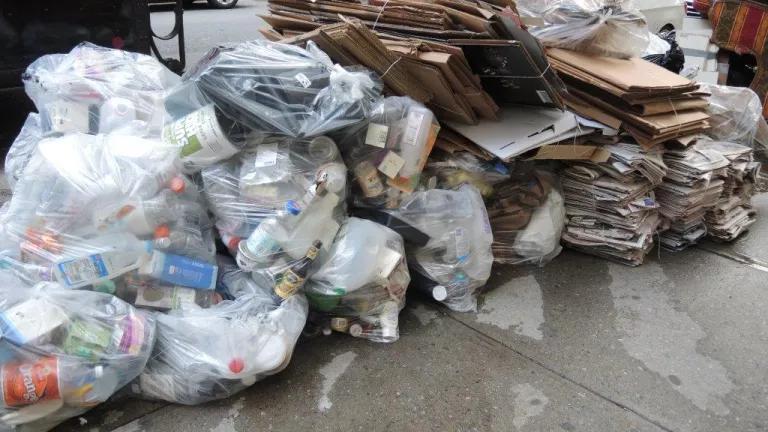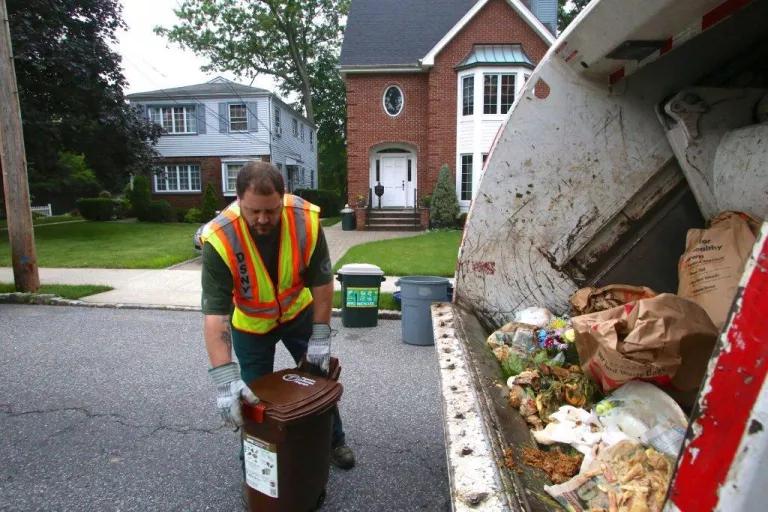
The 2000’s – The New Administration Stumbles at the Start
Mayor Michael Bloomberg, who took office in 2002, compiled an impressive track record in addressing environmental health and sustainability issues in New York City. But he didn’t start off as a big fan of recycling or of Local Law 19 of 1989, the City’s recycling Magna Carta.
Indeed, in 2002, the Sanitation Department proposed to eliminate recycling collections of metals, plastic and glass. The Bloomberg Administration suggested that such a move would save 57 million dollars a year, although the Department was never able to document that claim.
Again, the New York City Council came to the rescue. Thanks to Speaker Gifford Miller and Sanitation Committee Chair Mike McMahon, a compromise was reached; metals would stay in the program, plastics would be suspended but only until 2003 and glass collections would be suspended but would return in 2004.
Unfortunately, these stops and starts -- on top of what had already been a program under attack from the previous administration -- further confused the public. In part as a result of these changes, participation in the curbside recycling program declined.
In December 1999, the citywide residential and institutional recycling tonnage collected by the Sanitation Department had reached about 2,500 tons per day, a rate of over 21 percent. By December 2002, however, the citywide recycling tonnage collected by the Department had declined to about 1,550 tons per day, just under 13 percent. And even after the plastic and glass recycling collections were restored, the numbers did not fully bounce back.
In the summer of 2010, the City Council, under the leadership of Speaker Christine Quinn and Sanitation Committee Chair Tish James, enacted eleven new recycling laws. They were designed to update Local Law 19 of 1989 and to advance its original objectives. Among other things, the new laws sought to expand recycling collections to cover additional kinds of plastics, boost recycling in public schools, increase recycling in public spaces, and jumpstart food waste composting.
Another one of the laws established revised goals for recycling tonnages. It modified the original tonnage mandates of the 1989 statute and set 2020 as the final date for achieving a 25% rate for citywide residential recycling collected by the Sanitation Department at curbside and a 33% goal for all residential recyclables – those collected at curbside by the Department as well as residential refuse recycled by other means (e.g., bottles and cans redeemed under the state’s bottle deposit program, composting programs, electronic waste and other retailer take-back programs, etc.).
In a large number of New York neighborhoods, including Manhattan’s Upper West Side pictured here, many residents and building managers are complying with the city’s recycling law by separating newspapers, cardboard, metals, glass and plastics for curbside collection. But, 25 years after the City Council’s passage of Local Law 19, there are still challenges to be addressed in order for New York City to reap all of the economic and environmental benefits of recycling.
2012 – Team Bloomberg Launches Bold New Recycling Initiatives
In the spring of 2012, the Bloomberg Administration’s big turnaround began. The Mayor sought to make up for lost time by appointing the first-ever Deputy Commissioner for Recycling and Sustainability, Ron Gonen -- a savvy entrepreneur with the talent to help expand recycling cost-effectively. The appointment was championed by Deputy Mayor Cas Holloway, who understood that the rising costs of landfilling could make recycling economically attractive and that stepped up recycling would mesh well with the Mayor’s greenhouse gas reduction goals.
Then, in the summer of 2013, Mayor Bloomberg announced that the city would begin collecting all rigid plastics as part of its recycling collections. This change marked what Sanitation officials and waste experts hope will be the beginning of the end of years of confusion as to which plastics go in which receptacles. And it reflects the reality that genuine markets to purchase many (but not all) types of plastic waste have emerged over the past twenty five years.
The Administration also launched ambitious pilot projects designed to jumpstart curbside collections of food waste from households on Staten Island, high rise residences in Manhattan, and city public schools. These demonstration projects were revolutionary because food wastes and other organics account for more than 25% of the city’s residential waste stream. Get food scraps and yard waste out of landfills and incinerators and you’ve struck a powerful blow against pollution-generating and economically unsound waste disposal practices.
At the same time, the Sanitation Department kicked off enhanced programs to make recycling of textiles and electronic waste much more convenient for apartment-dwellers. The Department’s re-fashioNYC program is run jointly with a non-profit group, Housing Works. At the request of building managers, the city has been installing permanent bins for collecting clothing in apartment buildings of ten or more units (over 460 now and more being added); when the bins are filled, occupants notify the Department/Housing Works team, which arranges to empty the bins and reuse or recycle the contents for charitable purposes.
A companion to clothing and textile collections is the city’s recently launched e-cycleNYC program. For this new initiative, the Department has been installing separate bins (now over 300 and more available) in high-rise buildings that give residents a convenient place to drop off their old computers, televisions, and other unwanted electronic waste; when notified that bins are full, the city and its partner, Electronics Recyclers International, collect these wastes for reuse or for disassembly and recycling. (This initiative is supplementing the still-ongoing Lower East Side Ecology Center’s e-waste drop-off program, which has for years been a savior to New Yorkers who could not get themselves to toss old electronics, with their toxic constituents, out with the household trash.)
As 2013 came to a close, the Bloomberg Administration was also celebrating the long-awaited opening of a beautiful, new recycling facility on the Brooklyn waterfront in Sunset Park. Sims Municipal Recycling – the company that is handling all of the city’s metals, glass and plastic recyclables under a 20 year contract with the city -- now has a modern sorting plant that is providing green jobs for New Yorkers and moving most of its recyclables by barge and rail.
Last but not least, Mayor Bloomberg advanced two forward-looking bills that were passed by the City Council and signed by the Mayor in his last month in office. One law set the stage for the Sanitation Department to phase out the polystyrene food and beverage containers in New York City. It requires the Commissioner to prohibit the use of such containers unless she concludes by the end of this year that this problematic waste can somehow be recycled in an economically and environmentally sound manner.
The second law gave another boost to composting and other sustainable organics handling strategies. It directs large scale commercial generators of food waste in the city to insure that their organic materials are sent to composting or similar facilities (rather than to landfills or incinerators) beginning in July 2015 -- provided that sufficient capacity to sustainably handle such food wastes exists in the region by that time.

In one of the most promising developments on the solid waste scene in New York City, the Bloomberg Administration started, and the de Blasio Administration is expanding, pilot programs in which the Sanitation Department is collecting food scraps from private residences, high-rise apartments and city public schools for composting. Food waste and yard waste account for more than 25% of the residential waste stream, so organics collections programs like this, if phased in across the city, could dramatically cut the amount of waste sent to landfills and incinerators, saving city tax dollars and reducing global warming emissions and other pollution.
A third and concluding section of this blog will review the de Blasio Administration’s record to date in advancing the recycling objectives set forth in Local Law 19 of 1989. It will also identify seven things to look for over the next several years as the new Administration moves forward with what we hope will become the final chapter in the Local Law 19 story -- the transformation of New York City into a national leader on sustainable waste practices. Read Part I of the series here.

